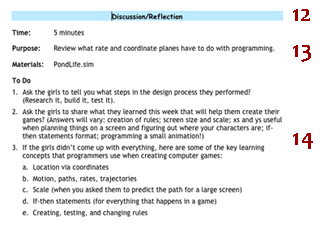Curriculum layout
Every lesson includes leader preparation materials and curriculum sections. Every page of the curriculum includes guiding headers and footers (see image below, 1), stating unit and week numbers. The beginning of each lesson is marked by the title in bold (2)
Units 1, 2, 4, and 5. Semester units were designed for an afterschool setting, where youth would be enrolled in a 10 - 15 weeks program for 2 hours and 20 minutes each week (assuming two 70-minute sessions).
Units 3 and 6. Summer units were designed assuming youth participate for 2 and a half hours daily for 10 consecutive days.

The Summary, Getting Ready, and Activity Pages sections were written to help leaders prepare for a week's activities.
The Summary section (3) includes:
- Schedule and goals (4), with a breakdown of time for Warm Up, Challenge, Main Activity, and Reflection
- Essential Questions (5) guiding the whole unit
- Design Process concepts (6), such as brainstorm, sketch it, research it
- Vocabulary definitions (7)
- Materials (8) used during this activity

Getting Ready (9) includes:
- a brief overview of the lesson (10)
- background information for the leader (11), such as key concepts and planning suggestions

Every 140 minute lesson consists of the following types of activities:
- Warm-up
- Challenge
- Main Activity
- Discussion / Reflection (12) for the youth to reflect on learning over the week and the Design Process steps used
Time, purpose and materials (13), and a step-by-step guide (To Do, 14) are listed for every activity type.
Managers/Coordinators/Directors
 |
© 2013-2016 SRI International. 333 Ravenswood Ave. Menlo Park, CA 94205. Produced by the Center for Technology in Learning at SRI International with support from the National Science Foundation under Grant Nos. 1339181, 1232461, and 0524762. Any opinions, findings, conclusions, or recommendations expressed are those of the authors and do not necessarily reflect the views of the National Science Foundation. |

|

